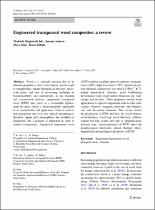JavaScript is disabled for your browser. Some features of this site may not work without it.
- ResearchSpace
- →
- Research Publications/Outputs
- →
- Journal Articles
- →
- View Item
| dc.contributor.author |
Jele, Thabisile B

|
|
| dc.contributor.author |
Andrew, Jerome E

|
|
| dc.contributor.author |
Mathew, Maya J

|
|
| dc.contributor.author |
Sithole, Bruce

|
|
| dc.date.accessioned | 2024-01-19T12:56:57Z | |
| dc.date.available | 2024-01-19T12:56:57Z | |
| dc.date.issued | 2023-05 | |
| dc.identifier.citation | Jele, T.B., Andrew, J.E., Mathew, M.J. & Sithole, B. 2023. Engineered transparent wood composites: A review. <i>Cellulose, 30.</i> http://hdl.handle.net/10204/13528 | en_ZA |
| dc.identifier.issn | 0969-0239 | |
| dc.identifier.issn | 1572-882X | |
| dc.identifier.uri | https://doi.org/10.1007/s10570-023-05239-z | |
| dc.identifier.uri | http://hdl.handle.net/10204/13528 | |
| dc.description.abstract | Wood is a versatile resource due to its inherent properties such as low density, good weight to strength ratio, unique hierarchical structure, microscale pores, and ease of processing, including its biodegradability and renewability. In the building and construction industry, engineered transparent wood (ETW) may serve as a sustainable replacement for glass which is environmentally unfriendly in its manufacture and application. Natural wood is non transparent due to its low optical transmittance, therefore, lignin and chromophores are modified or eliminated, and a polymer is infiltrated in order to achieve transparency. Engineered transparent wood (ETW) exhibits excellent optical properties (transmittance>80%), high haze (haze>70%), thermal insulation (thermal conductivity less than 0.23Wm-1 K-1), unique hierarchical structure, good loadbearing performance with tough failure behaviour (no shattering) and ductility. These properties extend wood applications to optical components such as solar cells, screens, windows, magnetic materials, and luminescent and decorative materials. This review details the production of ETW and how the wood density, wood thickness, wood type, wood direction, cellulose volume fraction, extent and type of delignification, polymer type, functionalisation of ETW affect the morphological, functional, optical, thermal, photodegradation and mechanical properties of ETW. | en_US |
| dc.format | Fulltext | en_US |
| dc.language.iso | en | en_US |
| dc.relation.uri | https://link.springer.com/article/10.1007/s10570-023-05239-z | en_US |
| dc.source | Cellulose, 30 | en_US |
| dc.subject | Transparent wood composites | en_US |
| dc.subject | Engineered transparent wood | en_US |
| dc.subject | ETW | en_US |
| dc.title | Engineered transparent wood composites: A review | en_US |
| dc.type | Article | en_US |
| dc.description.pages | 5447–5471 | en_US |
| dc.description.note | © The Author(s) 2023 | en_US |
| dc.description.cluster | Chemicals | en_US |
| dc.description.impactarea | BT Biorefinery | en_US |
| dc.description.impactarea | Advanced Polymer Composites | en_US |
| dc.identifier.apacitation | Jele, T. B., Andrew, J. E., Mathew, M. J., & Sithole, B. (2023). Engineered transparent wood composites: A review. <i>Cellulose, 30</i>, http://hdl.handle.net/10204/13528 | en_ZA |
| dc.identifier.chicagocitation | Jele, Thabisile B, Jerome E Andrew, Maya J Mathew, and Bruce Sithole "Engineered transparent wood composites: A review." <i>Cellulose, 30</i> (2023) http://hdl.handle.net/10204/13528 | en_ZA |
| dc.identifier.vancouvercitation | Jele TB, Andrew JE, Mathew MJ, Sithole B. Engineered transparent wood composites: A review. Cellulose, 30. 2023; http://hdl.handle.net/10204/13528. | en_ZA |
| dc.identifier.ris | TY - Article AU - Jele, Thabisile B AU - Andrew, Jerome E AU - Mathew, Maya J AU - Sithole, Bruce AB - Wood is a versatile resource due to its inherent properties such as low density, good weight to strength ratio, unique hierarchical structure, microscale pores, and ease of processing, including its biodegradability and renewability. In the building and construction industry, engineered transparent wood (ETW) may serve as a sustainable replacement for glass which is environmentally unfriendly in its manufacture and application. Natural wood is non transparent due to its low optical transmittance, therefore, lignin and chromophores are modified or eliminated, and a polymer is infiltrated in order to achieve transparency. Engineered transparent wood (ETW) exhibits excellent optical properties (transmittance>80%), high haze (haze>70%), thermal insulation (thermal conductivity less than 0.23Wm-1 K-1), unique hierarchical structure, good loadbearing performance with tough failure behaviour (no shattering) and ductility. These properties extend wood applications to optical components such as solar cells, screens, windows, magnetic materials, and luminescent and decorative materials. This review details the production of ETW and how the wood density, wood thickness, wood type, wood direction, cellulose volume fraction, extent and type of delignification, polymer type, functionalisation of ETW affect the morphological, functional, optical, thermal, photodegradation and mechanical properties of ETW. DA - 2023-05 DB - ResearchSpace DP - CSIR J1 - Cellulose, 30 KW - Transparent wood composites KW - Engineered transparent wood KW - ETW LK - https://researchspace.csir.co.za PY - 2023 SM - 0969-0239 SM - 1572-882X T1 - Engineered transparent wood composites: A review TI - Engineered transparent wood composites: A review UR - http://hdl.handle.net/10204/13528 ER - | en_ZA |
| dc.identifier.worklist | 26938 | en_US |
| dc.identifier.worklist | 26934 | en_US |






